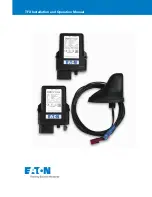
Maintenance and Troubleshooting
ST94-21 C/Ku-Band TVRO
13-12
the signal coming from the targeted satellite. The 24VDC motor is remotely controlled by the ACU (Manual
OR Auto-Polarization) through the PCU and Shielded Polang Relay Assy.
Two fixed frequency C-Band LNBs and one Quad Ku-Band LNBs are installed. Both C-Band polarizations (H &
V) are routed to J1 of the coax switches mounted on a C/Ku Switch Panel. Both Ku-Low Band polarizations
(H&V) are routed to J2 of the coax switches. The coax switches are controlled from the ACU MODE –
TRACKING Band Selection through the PCU and the Shielded Polang Relay Assy. The ACU band selection will
route either the C-Band, OR the Ku-Low Band, signals through two of the channels of the rotary joint. The
other two channels of the coax rotary joint are the (un-switched) Ku-High Band outputs of the Quad Ku LNB.
13.7.2.1.
Channel 1 (White)
HORIZ C/Ku-low coax has +18 VDC Voltage supplied by Matrix Switch plus C-Band IF (950-
1450MHz) OR Ku-Band IF (950-1950MHz) “Band Selected” output from the C/Ku-low Switch.
Horizontal C/Ku-low band switched output passes through this channel of the 75 ohm coaxial rotary
joint, to the base of the radome, down the ADE-BDE coax to the C/Ku HORIZ LO input of the four
port Matrix Switch. The ACUs’ Tracking Receiver and each of the C or Ku-Band Satellite Receivers is
connected by coax cable to one of the available IF outputs of the Matrix Switch. Total signal loss of
this path is the accumulation of the coax cable losses from antenna to receiver, plus the loss in the
C/Ku Switch and the Matrix Switch.
13.7.2.2.
Channel 2 (Blue)
VERT C/Ku-low coax has +13 VDC Voltage supplied by Matrix Switch plus C-Band IF (950-1450MHz)
OR Ku-Band IF (950-1950MHz) “Band Selected” output from the C/Ku-low Switch AND Antenna
Control RF (Pedestal TX at 1.1 & Base TX at 1.5 MHz) which is added onto this coax by the Pedestal
FSK Modem (connected to the PCU). Vertical C/Ku-low band switched output passes through this
channel of the 75 ohm coaxial rotary joint, to the base of the radome, down the ADE-BDE coax to
the Base FSK Modem (connected to the ACU) and then to the C/Ku VERT LO input of the four port
Matrix Switch. Total signal loss of this path is the accumulation of the coax cable losses from
antenna to receiver, plus the loss in the C/Ku Switch, Pedestal & Base Modems (1 dB max loss each)
and the Matrix Switch.
13.7.2.3.
Channel 3 (Red)
HORIZ Ku-high coax has +18 VDC Voltage supplied by Matrix Switch plus Ku-Band IF (1100-
2150MHz). Horizontal Ku-high band un-switched output passes through this channel of the 75 ohm
coaxial rotary joint, to the base of the radome, down the ADE-BDE coax to the Ku HORIZ HI input of
the four port Matrix Switch. Total signal loss of this path is the accumulation of the coax cable
losses from antenna to receiver, plus the loss in the Matrix Switch.
13.7.2.4.
Channel 4 (Green)
VERT Ku-high coax has +13 VDC Voltage supplied by Matrix Switch plus Ku-Band IF (1100-
2150MHz). Vertical Ku-high band un-switched output passes through this channel of the 75 ohm
coaxial rotary joint, to the base of the radome, down the ADE-BDE coax to the Ku VERT HI input of
the four port Matrix Switch. Total signal loss of this path is the accumulation of the coax cable
losses from antenna to receiver, plus the loss in the Matrix Switch.
13.7.3.
Antenna Initialization (ST-21 Series)
Turn the pedestal power supply ON. The brakes on the Elevation and Cross-Level motors will release. A brake
release power supply control circuit supplies 24 VDC to the brakes initially (5-10 seconds) and then reduces
the voltage to 12VDC. The PCU will initialize the stabilized portion of the mass to be level with the horizon
and at a prescribed Azimuth and Elevation angles in the specific sequence of steps listed below.
Initialization is completed in the following phases, each phase must complete properly for the antenna to
operate properly (post-initialization). Observe the Initialization of the antenna pedestal.
Step 1. Elevation and Cross-Level axes activate simultaneously - Input from the Elevation sensor is
used to drive the Elevation of the equipment frame to 45.0 degrees in elevation. Input from the
Cross-Level sensor is used to drive Cross-Level of the equipment frame to bring it to level (this
results in the tilt of the Cross-Level Beam being level).
Step 2. Azimuth axis activates - Antenna drives CW in azimuth until the “Home Flag” signal is
produced. This signal is produced by a Proximity sensor in close proximity to a metal tab. After a
short period of time (a total of approximately 1-2 Minutes after power is initially applied to the
antenna), the PCU will report its model setting and software version number to the Antenna Control
Unit (ACU).
EAR Controlled - ECCN EAR99
Summary of Contents for ST94-21
Page 4: ...EAR Controlled ECCN EAR99 ...
Page 10: ...Table of Contents x This Page Intentionally Left Blank EAR Controlled ECCN EAR99 ...
Page 123: ...EAR Controlled ECCN EAR99 ...
Page 126: ...EAR Controlled ECCN EAR99 ...
Page 139: ...EAR Controlled ECCN EAR99 ...
Page 140: ...EAR Controlled ECCN EAR99 ...
Page 141: ...EAR Controlled ECCN EAR99 ...
















































